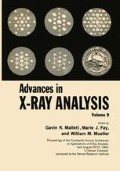Abstract
Deformation, introduced into niobium and tantalum specimens by wire drawing at room temperature, produced changes in the shape and position of X-ray diffraction peaks. The resultant peak profiles and locations of all available peaks were recorded using the Debye—Scherrer geometry on a modified diffractometer with crystal monochromated Cu K α1 radiation. The amount of deformation in the surface layers of both metals was’found to saturate essentially after only 20% reduction in area. The measured decrease in the lattice parameters of either material was attributed to a residual surface stress; the average value for the deformed saturated state for both tantalum and niobium wires corresponded to an equivalent longitudinal tensile stress of 35 ± 5 kg/mm2. Integral breadth measurements revealed approximately equal X-ray particle sizes in the ‹100› and ‹110› directions; the minimum particle size for the microstructures of both metals was around 200 Å and occurred after the first few draws.
Access this chapter
Tax calculation will be finalised at checkout
Purchases are for personal use only
Preview
Unable to display preview. Download preview PDF.
References
Latrobe Steel Company, Bulletin 100, Tech Topics: Stainless Steels, Latrobe, Pennsylvania 1961.
Metals Handbook,Vol. 1,8th ed., American Society for Metals, Metals Park, Ohio, 1961, pp. 153, 1202, 1222, 1225.
W. O. Everling, “Super-High Strength Wire, A Component of Metallic Composites,” in: Proc. 6th Sagamore Ordnance Matls. Res. Conf., Composite Materials and Composite Structures, Racquette Lake, N.Y., 1959.
J. D. Embury and R. M. Fisher, “The Structure and Properties of Drawn Pearlite,” Acta Met. 14: 147–159, 1966.
W. M. Baldwin, Jr., “Residual Stress in Metals, ”Proceedings of the American Society for Testing Materials 49: 1–45, 1949.
T. A. Trozera, “On the Nonhomogeneous Work for Wire Drawing,” Trans. ASME 57: 309–323, 1964.
D. I. Bolef, “Elastic Constants of Single Crystals of the Body-Centered Cubic Transition Elements V, Nb, and Ta,” J. Appl. Phys. 32: 100–105, 1961.
G. B. Greenough, “Quantitative X-Ray Diffraction Observations in Strained Metal Aggregates,” Progr. Metal Phys. 3: 176–219, 1952.
H. M. Otte, “Lattice-Parameter Determinations with an X-Ray Spectrogoniometer by the Debye-Scherrer Method and the Effect of Specimen Condition,” J. Appl. Phys. 32: 1536–1346, 1961.
J. B. Nelson and D. P. Riley, “An Experimental Investigation of Extrapolation Methods in the Derivation of Accurate Unit Cell Dimensions of Crystals,” Proc. Phys. Soc. (London) 57: 160177, 1945.
B. E. Warren, “X-Ray Studies of Deformed Metals,” Progr. Metal. Phys. 8: 147–202, 1958.
C. N. J. Wagner, A. S. Tetelman, and H. M. Otte, “Diffraction from Layer Faults in bcc and fcc Structure,” J. Appl. Phys. 33: 3080–3086, 1962.
C. N. J. Wagner, “Analysis of the Broadening and Changes in Position of X-ray Powder Pattern Peaks,” in: J. B. Cohen and J. E. Hilliard (eds.), Local Atomic Arrangements Studied by X-Ray Diffraction, Gordon and Breach, New York, 1965, Chapt. 6.
A. Taylor, X-Ray Metallography, John Wiley & Sons, Inc., New York, 1961, pp. 605, 692, 788.
D. O. Welch and H. M. Otte, “The Effect of Cold-Work on the X-Ray Diffraction Pattern of a Copper-Silicon-Manganese Alloy,” in: W. M. Mueller and M. J. Fay (eds.), Advances in X-Ray Analysis, Vol. 6, 1963, p. 96–120.
T. W. Barbee and R. A. Huggins, “Dislocation Structures in Deformed and Recovered Tantalum,” J. Less-Common Metals 8: 306–319, 1965.
L. I. van Tome and G. Thomas, “Yielding and Plastic Flow in Niobium,” Acta Met. 11: 88 1893, 1963.
A. J. Opinsky, J. L. Orehotsky and C. W. W. Hoffman, “X-Ray Diffraction Analysis of Crystallite Size and Lattice Strain in Tungsten Wire,” J. Appl. Phys. 33: 708–712, 1962.
E. N. Aqua and C. N. J. Wagner, “X-Ray Diffraction Study of Deformation by Filing in bcc Refractory Metals,” Phil. Mag. 9: 565–589, 1964.
H. M. Otte and J. J. Hren, Experimental Mechanics 6: 177–193, 1966.
A. L. Mincher and W. F. Sheely, “Effect of Structure and Purity on the Mechanical Properties of Niobium,” Trans AIME 221: 19–25, 1961.
E. S. Bartlett, D. N. Williams, H. R. Ogden, R. I. Jaffee, and E. F. Bradley, “High Temperature Solid-Solution-Strengthened Columbium Alloys,” Trans. Met. Soc. AIME 227: 459–467, 1963.
M. A. Adams, A C. Roberts, and R. E. Smallman, “Yield and Fracture in Polycrystalline Niobium,” Acta Met. 8: 328–337, 1960.
M. Schussler and J. S. Brunhouse, Jr., “Mechanical Properties of Tantalum Metal Consolidated by Melting,” Trans. AIME 218: 893–900, 1960.
C. S. Tedmon and D. P. Ferris, “The Dependence of Yield Stress on Grain Size for Tantalum and a 10% W-90% Ta Alloy,” Trans. AIME 224: 1079–1080, 1962.
Author information
Authors and Affiliations
Editor information
Rights and permissions
Copyright information
© 1966 Springer Science+Business Media New York
About this paper
Cite this paper
Adler, R.P.I., Otte, H.M. (1966). X-Ray Study of Wire-Drawn Niobium and Tantalum. In: Mallett, G.R., Fay, M.J., Mueller, W.M. (eds) Advances in X-Ray Analysis. Springer, Boston, MA. https://doi.org/10.1007/978-1-4684-7633-0_10
Download citation
DOI: https://doi.org/10.1007/978-1-4684-7633-0_10
Publisher Name: Springer, Boston, MA
Print ISBN: 978-1-4684-7635-4
Online ISBN: 978-1-4684-7633-0
eBook Packages: Springer Book Archive

